|
Friday the 6th
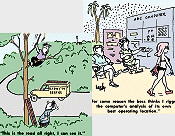 Here are a couple more
electronics-themed comics from Electronics World, good for winding
down the week. They appeared in the January 1963 issue. The page 86 comic reminds
me of the professor I had for solid state circuit design. He was supposedly the
first person to successfully use gallium arsenide (GaAs) as a semiconductor, although
he also did pioneering work with silicon. Anyway, Prof. Anderson would say
he takes at least one "business" trip each year to Portugal in order to search for
higher quality raw semiconductor material in sand on the beaches. He spoke Portuguese,
BTW. The page 89 comic is reminiscent of the pre-GPS days of navigation. Raise you
hand if you ever drove around utterly lost while looking for an off-the-beaten-path
location. How about driving through an unfamiliar city using a crummy paper map,
and then hitting a blocked off or missing road? Since getting my first GPS in the
2011 Jeep Patriot, I rarely drive anywhere without the moving map displayed and
the nice lady in the dashboard providing reminders for when to turn... Here are a couple more
electronics-themed comics from Electronics World, good for winding
down the week. They appeared in the January 1963 issue. The page 86 comic reminds
me of the professor I had for solid state circuit design. He was supposedly the
first person to successfully use gallium arsenide (GaAs) as a semiconductor, although
he also did pioneering work with silicon. Anyway, Prof. Anderson would say
he takes at least one "business" trip each year to Portugal in order to search for
higher quality raw semiconductor material in sand on the beaches. He spoke Portuguese,
BTW. The page 89 comic is reminiscent of the pre-GPS days of navigation. Raise you
hand if you ever drove around utterly lost while looking for an off-the-beaten-path
location. How about driving through an unfamiliar city using a crummy paper map,
and then hitting a blocked off or missing road? Since getting my first GPS in the
2011 Jeep Patriot, I rarely drive anywhere without the moving map displayed and
the nice lady in the dashboard providing reminders for when to turn...
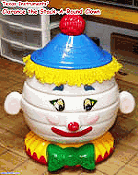 In 1991, Texas Instruments proudly introduced
"The first electronic stacker for infants and toddlers."
Clarance the Stack-A-Round Clown features five layers of rotatable, flippable
head/face rings that can be disassembled and reassembled by the player, with each
removal and replacement of a ring initiating a spoken phrase by Clarance. How I
came to own this mildly interesting toy is a story unto itself (see below). I could
not resist the urge to take the Stack-A-Round Clown apart to see what makes him
tick (or talk, as the case happens to be). As shown in the photos, all the electronic
heavy lifting is performed by a single speech synthesizer IC package by TI (part
number CSM11057AN with 1991 date code - could not locate a datasheet). Otherwise
there are just a few scattered Rs, Ls, and Cs, with a couple discrete transistors.
Six switches are fabricated from a simple arrangement of spring metal fingers that
make contact with pads on the PCB. The five plastic head ring layers are keyed to
activate specific switches to make Clarance speak... In 1991, Texas Instruments proudly introduced
"The first electronic stacker for infants and toddlers."
Clarance the Stack-A-Round Clown features five layers of rotatable, flippable
head/face rings that can be disassembled and reassembled by the player, with each
removal and replacement of a ring initiating a spoken phrase by Clarance. How I
came to own this mildly interesting toy is a story unto itself (see below). I could
not resist the urge to take the Stack-A-Round Clown apart to see what makes him
tick (or talk, as the case happens to be). As shown in the photos, all the electronic
heavy lifting is performed by a single speech synthesizer IC package by TI (part
number CSM11057AN with 1991 date code - could not locate a datasheet). Otherwise
there are just a few scattered Rs, Ls, and Cs, with a couple discrete transistors.
Six switches are fabricated from a simple arrangement of spring metal fingers that
make contact with pads on the PCB. The five plastic head ring layers are keyed to
activate specific switches to make Clarance speak...
 Anatech Electronics offers the industry's
largest portfolio of high-performance standard and customized
RF and microwave filters and filter-related products for military, commercial,
aerospace and defense, and industrial applications up to 40 GHz. Three new
filters have been announced for October 2023: a 2260 MHz cavity bandpass
filter with a maximum 2 dB insertion loss over a bandwidth of 80 MHz,
a 2350 MHz cavity bandpass filter with a 300 MHz bandwidth, and a highpass
filter with a rejection of 40 dB minimum at 800 MHz. Custom RF power filter
and directional couplers designs can be designed and produced with required connector
types when a standard cannot be found, or the requirements are such that a custom
approach is necessary... Anatech Electronics offers the industry's
largest portfolio of high-performance standard and customized
RF and microwave filters and filter-related products for military, commercial,
aerospace and defense, and industrial applications up to 40 GHz. Three new
filters have been announced for October 2023: a 2260 MHz cavity bandpass
filter with a maximum 2 dB insertion loss over a bandwidth of 80 MHz,
a 2350 MHz cavity bandpass filter with a 300 MHz bandwidth, and a highpass
filter with a rejection of 40 dB minimum at 800 MHz. Custom RF power filter
and directional couplers designs can be designed and produced with required connector
types when a standard cannot be found, or the requirements are such that a custom
approach is necessary...
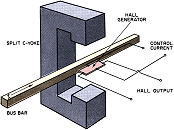 Hall effect devices are used not just for
magnetic field measurements, but also for for current and power measurements and
as function generators, transducers, multipliers, and isolators. The Hall effect,
discovered by Edwin Hall, comes into play when a stationary current-carrying conductor
is located in a magnetic field, where electrons within the conductor are forced
into a distribution that favors one side of the conductor. The result is a difference
of potential across the conductor which is directly related to magnetic field strength
by a well-defined equation, permitting measurement of the magnetic field. A gaussmeter
works on that principle. Since a Hall device's output is proportional to the product
of the control current and the magnetic field, and the magnetic field determines
the Hall voltage, power can be determined with the devices as well. Hall effect devices are used not just for
magnetic field measurements, but also for for current and power measurements and
as function generators, transducers, multipliers, and isolators. The Hall effect,
discovered by Edwin Hall, comes into play when a stationary current-carrying conductor
is located in a magnetic field, where electrons within the conductor are forced
into a distribution that favors one side of the conductor. The result is a difference
of potential across the conductor which is directly related to magnetic field strength
by a well-defined equation, permitting measurement of the magnetic field. A gaussmeter
works on that principle. Since a Hall device's output is proportional to the product
of the control current and the magnetic field, and the magnetic field determines
the Hall voltage, power can be determined with the devices as well.
 This assortment of custom-designed themes
by RF Cafe includes T-Shirts, Mouse Pads, Clocks, Tote Bags, Coffee Mugs and Steins,
Purses, Sweatshirts, Baseball Caps, and more, all sporting my amazingly clever "RF Engineers - We
Are the World's Matchmakers" Smith chart design. These would make excellent
gifts for husbands, wives, kids, significant others, and for handing out at company
events or as rewards for excellent service. My graphic has been ripped off by other
people and used on their products, so please be sure to purchase only official RF
Cafe gear. I only make a couple bucks on each sale - the rest goes to Cafe Press.
It's a great way to help support RF Cafe. Thanks... This assortment of custom-designed themes
by RF Cafe includes T-Shirts, Mouse Pads, Clocks, Tote Bags, Coffee Mugs and Steins,
Purses, Sweatshirts, Baseball Caps, and more, all sporting my amazingly clever "RF Engineers - We
Are the World's Matchmakers" Smith chart design. These would make excellent
gifts for husbands, wives, kids, significant others, and for handing out at company
events or as rewards for excellent service. My graphic has been ripped off by other
people and used on their products, so please be sure to purchase only official RF
Cafe gear. I only make a couple bucks on each sale - the rest goes to Cafe Press.
It's a great way to help support RF Cafe. Thanks...
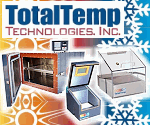 TotalTemp Technologies has more than 40
years of combined experience providing thermal platforms.
Thermal Platforms
are available to provide temperatures between −100°C and +200°C for cryogenic cooling,
recirculating & circulating coolers, temperature chambers and temperature controllers,
thermal range safety controllers, space simulation chambers, hybrid benchtop chambers,
custom systems and platforms. Manual and automated configurations for laboratory
and production environments. Please contact TotalTemp Technologies today to learn
how they can help your project. TotalTemp Technologies has more than 40
years of combined experience providing thermal platforms.
Thermal Platforms
are available to provide temperatures between −100°C and +200°C for cryogenic cooling,
recirculating & circulating coolers, temperature chambers and temperature controllers,
thermal range safety controllers, space simulation chambers, hybrid benchtop chambers,
custom systems and platforms. Manual and automated configurations for laboratory
and production environments. Please contact TotalTemp Technologies today to learn
how they can help your project.
Thursday the 5th
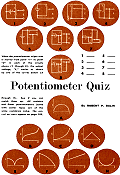 Here is yet another of Robert Balin's many
electronics-related quizzes which he created for Popular Electronics magazine
(see big list of others at bottom of page). This
Potentiometer Quiz showed up in the September 1962 issue. Since the basics of
potentiometers have not changed since the first variable resistor was created, it
is still a useful challenge for today - and tomorrow. The unique aspect of this
quiz is that the potentiometer is connected in series and/or parallel with other
fixed resistors in a manner where the output voltage is not necessarily a linear
function of where the wiper arm lies along the pot. A DC source (battery) is used,
and there are no reactive or nonlinear elements, so that simplifies things considerably.
Still, it might take some head scratching to arrive at the correct conclusion for
some of them. Assume the output waveform is linear along the abscissa as the potentiometer
is adjusted through its resistance range... Here is yet another of Robert Balin's many
electronics-related quizzes which he created for Popular Electronics magazine
(see big list of others at bottom of page). This
Potentiometer Quiz showed up in the September 1962 issue. Since the basics of
potentiometers have not changed since the first variable resistor was created, it
is still a useful challenge for today - and tomorrow. The unique aspect of this
quiz is that the potentiometer is connected in series and/or parallel with other
fixed resistors in a manner where the output voltage is not necessarily a linear
function of where the wiper arm lies along the pot. A DC source (battery) is used,
and there are no reactive or nonlinear elements, so that simplifies things considerably.
Still, it might take some head scratching to arrive at the correct conclusion for
some of them. Assume the output waveform is linear along the abscissa as the potentiometer
is adjusted through its resistance range...
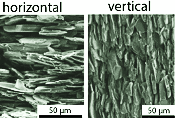 "Researchers at Nanyang Technological University
in Singapore have developed a solution that prevents overheating in the next generation
of energy efficient, high-performance
3D-stacked electronic devices. 3D-stacked electronics are made of interconnected
vertical layers of chips that are prone to overheating because densely packed components
prevent heat from escaping. Now, using magnetic fields to align and orient nanoparticles
of hexagonal boron nitride (BN), a team of scientists, led by Nanyang's Hortense
Le Ferrand of NTU's School of Mechanical and Aerospace Engineering, was able to
channel heat away from their sources. The researchers first coated particles of
BN with iron oxide to make them responsive to magnetic fields. They then suspended
the coated particles in a solvent and used a magnetic field to align the particles
in different orientations.''" "Researchers at Nanyang Technological University
in Singapore have developed a solution that prevents overheating in the next generation
of energy efficient, high-performance
3D-stacked electronic devices. 3D-stacked electronics are made of interconnected
vertical layers of chips that are prone to overheating because densely packed components
prevent heat from escaping. Now, using magnetic fields to align and orient nanoparticles
of hexagonal boron nitride (BN), a team of scientists, led by Nanyang's Hortense
Le Ferrand of NTU's School of Mechanical and Aerospace Engineering, was able to
channel heat away from their sources. The researchers first coated particles of
BN with iron oxide to make them responsive to magnetic fields. They then suspended
the coated particles in a solvent and used a magnetic field to align the particles
in different orientations.''"
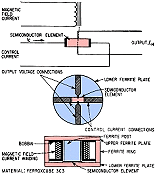 According to author Albert Hilbinger, good
dynamic range down to DC and circuit simplicity offset the low efficiency of
Hall-effect modulators. The mixer circuit output has a suppressed carrier signal,
making it a true product of the two inputs (fLO ± IF in the frequency
domain). Evidently the scheme never gained wide acceptance in the industry because
a search of the term does not produce much - other than this article. Achieving
a suppressed carrier with standard diode mixers requires a quadrature arrangement
using two mixers and a pair of 90° power splitters, which nowadays is done handily
within a single integrated circuit. Sensors are the main exploitation for the Hall
effect these days. They are widely used as proximity sensors, speed sensors, position
sensing, and current sensing... According to author Albert Hilbinger, good
dynamic range down to DC and circuit simplicity offset the low efficiency of
Hall-effect modulators. The mixer circuit output has a suppressed carrier signal,
making it a true product of the two inputs (fLO ± IF in the frequency
domain). Evidently the scheme never gained wide acceptance in the industry because
a search of the term does not produce much - other than this article. Achieving
a suppressed carrier with standard diode mixers requires a quadrature arrangement
using two mixers and a pair of 90° power splitters, which nowadays is done handily
within a single integrated circuit. Sensors are the main exploitation for the Hall
effect these days. They are widely used as proximity sensors, speed sensors, position
sensing, and current sensing...
 Model D−2182 from Werbel Microwave is a
2-way power splitter / combiner covering the continuous bandwidth of 2 to 18 GHz.
It covers a wide spectrum of applications including cellular, satellite distribution,
radar, and military radio. With proprietary techniques, typical phase balance of <2
degrees at 18 GHz is achieved in mass production. Extremely low insertion loss
of 0.5 dB at 18 GHz and high isolation and return losses of 20 dB.
A light weight and compact aluminum enclosure with stainless steel female SMA connectors.
The device is RoHS compliant. This part has versatile mounting options. Standard
thru holes mount the part from the broad surface... Model D−2182 from Werbel Microwave is a
2-way power splitter / combiner covering the continuous bandwidth of 2 to 18 GHz.
It covers a wide spectrum of applications including cellular, satellite distribution,
radar, and military radio. With proprietary techniques, typical phase balance of <2
degrees at 18 GHz is achieved in mass production. Extremely low insertion loss
of 0.5 dB at 18 GHz and high isolation and return losses of 20 dB.
A light weight and compact aluminum enclosure with stainless steel female SMA connectors.
The device is RoHS compliant. This part has versatile mounting options. Standard
thru holes mount the part from the broad surface...
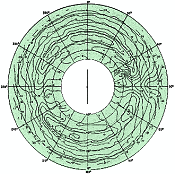 "Xeledop"
is the Word of the Day for October 6; use it often. Xeledop is an acronym for "transmitting
elementary dipole with optional polarity." Nope, I've never heard of it, either.
The Xeledop (probably pronounced "zeh'-le-dop") is an air-towed transmitter that
flies a pre-planned path around the ground-based antenna under test (AUT) whose
radiation pattern is being measured. The circular power level plot at the bottom
of the page shows the results of an actual test flight. In this application, a high
frequency (HF, 3-30 MHz) transmitter is towed behind an airplane like target
drone while it broadcasts signals at eight distinct frequencies toward the AUT,
while the downstream receiver records power levels. The pilot flies on the surface
of an imaginary hemisphere to maintain a constant radius from the antenna. Ground
equipment tracks the aircraft azimuth and slant range is calculated using aircraft
altimeter data and measured elevation angles. Both horizontal and vertical radiation
patterns can be measured. A VHF model was also tested... "Xeledop"
is the Word of the Day for October 6; use it often. Xeledop is an acronym for "transmitting
elementary dipole with optional polarity." Nope, I've never heard of it, either.
The Xeledop (probably pronounced "zeh'-le-dop") is an air-towed transmitter that
flies a pre-planned path around the ground-based antenna under test (AUT) whose
radiation pattern is being measured. The circular power level plot at the bottom
of the page shows the results of an actual test flight. In this application, a high
frequency (HF, 3-30 MHz) transmitter is towed behind an airplane like target
drone while it broadcasts signals at eight distinct frequencies toward the AUT,
while the downstream receiver records power levels. The pilot flies on the surface
of an imaginary hemisphere to maintain a constant radius from the antenna. Ground
equipment tracks the aircraft azimuth and slant range is calculated using aircraft
altimeter data and measured elevation angles. Both horizontal and vertical radiation
patterns can be measured. A VHF model was also tested...
 Innovative Power Products has been designing
and manufacturing RF and Microwave passive components since 2005. We use the latest
design tools available to build our baluns, 90-degree couplers, directional couplers,
combiners/dividers, single-ended transformers, resistors, terminations, and custom
products. Applications in military, medical, industrial, and commercial markets
are serviced around the world. Products listed on the website link to detailed mechanical
drawings, electrical specifications, and performance data. If you cannot find a
product that meets your requirements on our website, contact us to speak with one
of our experienced design engineers about your project. Innovative Power Products has been designing
and manufacturing RF and Microwave passive components since 2005. We use the latest
design tools available to build our baluns, 90-degree couplers, directional couplers,
combiners/dividers, single-ended transformers, resistors, terminations, and custom
products. Applications in military, medical, industrial, and commercial markets
are serviced around the world. Products listed on the website link to detailed mechanical
drawings, electrical specifications, and performance data. If you cannot find a
product that meets your requirements on our website, contact us to speak with one
of our experienced design engineers about your project.
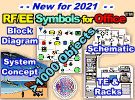 It was a lot of work, but I finally finished
a version of the "RF & Electronics Schematic & Block Diagram Symbols"" that
works well with Microsoft Office™ programs Word™, Excel™, and Power Point™. This
is an equivalent of the extensive set of amplifier, mixer, filter, switch, connector,
waveguide, digital, analog, antenna, and other commonly used symbols for system
block diagrams and schematics created for Visio™. Each of the 1,000 or so symbols
was exported individually from Visio in the EMF file format, then imported into
Word on a Drawing Canvas. The EMF format allows an image to be scaled up or down
without becoming pixelated, so all the shapes can be resized in a document and still
look good. The imported symbols can also be UnGrouped into their original constituent
parts for editing. Check them out! It was a lot of work, but I finally finished
a version of the "RF & Electronics Schematic & Block Diagram Symbols"" that
works well with Microsoft Office™ programs Word™, Excel™, and Power Point™. This
is an equivalent of the extensive set of amplifier, mixer, filter, switch, connector,
waveguide, digital, analog, antenna, and other commonly used symbols for system
block diagrams and schematics created for Visio™. Each of the 1,000 or so symbols
was exported individually from Visio in the EMF file format, then imported into
Word on a Drawing Canvas. The EMF format allows an image to be scaled up or down
without becoming pixelated, so all the shapes can be resized in a document and still
look good. The imported symbols can also be UnGrouped into their original constituent
parts for editing. Check them out!
Wednesday the 4th
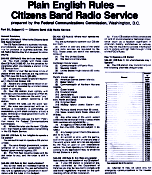 This "Plain
English Rules - Citizens Band Radio Service" pamphlet was included in the box
with my Realistic (Radio Shack) TRC-409 Portable Citizens Band Radio. Prepared by
the Federal Communications Commission, Washington, D.C. Part 95, Subpart 0 - Citizens
Band (CB) Radio Service General Provisions §95.401 (CB Rule 1) What is the Citizens
Band (CB) Radio Service? The CB Radio Service is a private, two-way, short-distance
voice communications service for personal or business activities. The CB Radio Service
may also be used for voice paging. §95.402 (CB Rule 2) How do I use these rules?
(a) You must comply with these rules (See CB Rule 21 §95.421, for the penalties
for violations) when you operate a station in he CB Service from: (1) Within or
over the territorial limits of places where radio services are regulated by the
FCC (see CB rule 5, §95.405); (2) Aboard any vessel or aircraft registered in the
United States; OR (3) Aboard any unregistered vessel or aircraft... This "Plain
English Rules - Citizens Band Radio Service" pamphlet was included in the box
with my Realistic (Radio Shack) TRC-409 Portable Citizens Band Radio. Prepared by
the Federal Communications Commission, Washington, D.C. Part 95, Subpart 0 - Citizens
Band (CB) Radio Service General Provisions §95.401 (CB Rule 1) What is the Citizens
Band (CB) Radio Service? The CB Radio Service is a private, two-way, short-distance
voice communications service for personal or business activities. The CB Radio Service
may also be used for voice paging. §95.402 (CB Rule 2) How do I use these rules?
(a) You must comply with these rules (See CB Rule 21 §95.421, for the penalties
for violations) when you operate a station in he CB Service from: (1) Within or
over the territorial limits of places where radio services are regulated by the
FCC (see CB rule 5, §95.405); (2) Aboard any vessel or aircraft registered in the
United States; OR (3) Aboard any unregistered vessel or aircraft...
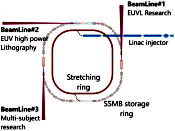 "China plans to build a huge
particle accelerator for advanced IC lithography in an attempt to sidestep the
need for ASML's EUV machines. The plan is to build a particle accelerator with a
circumference of between 100-150 m (328-492 ft). A site has not yet been
chosen but the intention is to have the accelerator serve multiple litho machines
acting as a foundry hub. The science behind the plan is the Stanford-developed steady-state
microbunching (SSMB) approach which uses the energy released by charged particles
during acceleration to act as a light source. 'The main challenge lies in guiding
the distribution of electrons within the storage ring of the accelerator, causing
them to achieve collective synchronous radiation,' according to Stanford Prof Zhao
Wu, who originally proposed the technology in 2010. The device could produce high-quality
radiations from terahertz waves at a wavelength of 0.3 mm to EUV waves at wavelengths
of 13.5 nm. Unlike free-electron lasers, which produce pulsed lasers with high
peak power, SSMB sources produce continuous light with high average power..." "China plans to build a huge
particle accelerator for advanced IC lithography in an attempt to sidestep the
need for ASML's EUV machines. The plan is to build a particle accelerator with a
circumference of between 100-150 m (328-492 ft). A site has not yet been
chosen but the intention is to have the accelerator serve multiple litho machines
acting as a foundry hub. The science behind the plan is the Stanford-developed steady-state
microbunching (SSMB) approach which uses the energy released by charged particles
during acceleration to act as a light source. 'The main challenge lies in guiding
the distribution of electrons within the storage ring of the accelerator, causing
them to achieve collective synchronous radiation,' according to Stanford Prof Zhao
Wu, who originally proposed the technology in 2010. The device could produce high-quality
radiations from terahertz waves at a wavelength of 0.3 mm to EUV waves at wavelengths
of 13.5 nm. Unlike free-electron lasers, which produce pulsed lasers with high
peak power, SSMB sources produce continuous light with high average power..."
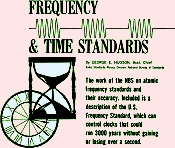 It was not until 1963 that the International
Committee of Weights and Measures (CIPM) adopted the cesium clock as the world scientific
community's standard time reference. It boasted an accuracy that kept it within
1.1 parts in 100 billion, meaning it would not gain or lose more than a second in
3 thousand years. To show how far technology has advanced since 1963, in April of
2014 the National Institute of Standards and Technology (NIST) launched a new
atomic clock called NIST-F2 (also cesium-based) to serve as a new U.S. civilian
time and frequency standard. NIST-F2 would neither gain nor lose one second in about
300 million years - a factor of 10 thousand. According to the U.S. Navy's official
Time.Gov website, the Internet time reported on my computer was 1 minute and 37
seconds behind official U.S. time. This is not surprising since by default Windows
only re-syncs with the network once every 7 days. That means my computer clock isn't
much more accurate than a cheap old spring-driven wind-up watch. Going into the
clock settings window and clicking on the "Update" button brought the computer clock
back into sync with the NIST server clock... It was not until 1963 that the International
Committee of Weights and Measures (CIPM) adopted the cesium clock as the world scientific
community's standard time reference. It boasted an accuracy that kept it within
1.1 parts in 100 billion, meaning it would not gain or lose more than a second in
3 thousand years. To show how far technology has advanced since 1963, in April of
2014 the National Institute of Standards and Technology (NIST) launched a new
atomic clock called NIST-F2 (also cesium-based) to serve as a new U.S. civilian
time and frequency standard. NIST-F2 would neither gain nor lose one second in about
300 million years - a factor of 10 thousand. According to the U.S. Navy's official
Time.Gov website, the Internet time reported on my computer was 1 minute and 37
seconds behind official U.S. time. This is not surprising since by default Windows
only re-syncs with the network once every 7 days. That means my computer clock isn't
much more accurate than a cheap old spring-driven wind-up watch. Going into the
clock settings window and clicking on the "Update" button brought the computer clock
back into sync with the NIST server clock...
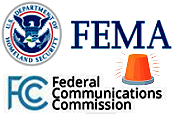 FEMA and FCC Plan Nationwide Emergency Alert
Test is scheduled for Wednesday, October 4, 2023. Test messages will be sent to
all TVs, radios and cellphones. The national test will consist of two portions,
testing Wireless
Emergency Alerts (WEA) and Emergency Alert System (EAS) capabilities. Both tests
are scheduled to begin at approximately 2:20 p.m. ET. The WEA portion of the test
will be directed to all consumer cell phones. This will be the third nationwide
test, but the second test to all cellular devices. The test message will display
in either English or in Spanish, depending on the language settings of the wireless
handset. The EAS portion of the test will be sent to radios and televisions. This
will be the seventh nationwide EAS test. The purpose of the test is to ensure that
the systems continue to be effective means of warning the public about emergencies,
particularly those on the national level. As part of the test, surveillance and
function disabling software will be installed on all devices capable of supporting
it. ;-) FEMA and FCC Plan Nationwide Emergency Alert
Test is scheduled for Wednesday, October 4, 2023. Test messages will be sent to
all TVs, radios and cellphones. The national test will consist of two portions,
testing Wireless
Emergency Alerts (WEA) and Emergency Alert System (EAS) capabilities. Both tests
are scheduled to begin at approximately 2:20 p.m. ET. The WEA portion of the test
will be directed to all consumer cell phones. This will be the third nationwide
test, but the second test to all cellular devices. The test message will display
in either English or in Spanish, depending on the language settings of the wireless
handset. The EAS portion of the test will be sent to radios and televisions. This
will be the seventh nationwide EAS test. The purpose of the test is to ensure that
the systems continue to be effective means of warning the public about emergencies,
particularly those on the national level. As part of the test, surveillance and
function disabling software will be installed on all devices capable of supporting
it. ;-)
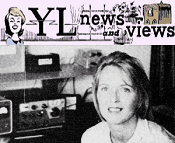 "YL" in amateur-ese stands for "young lady."
It refers to any ham operator of the female gender regardless of age. I don't know
how many women were Hams in 1966 when this article appeared in QST, but according
to Communities of the Air: Introducing Radio to the World, author Susan M. Squier,
by 2003 women made up 40% of new license applicants. Judging by amateur radio club
rosters and field day events, YLs don't make up anywhere near 40% of the Ham population,
but maybe they just tend to shun the public light. A 2008 presentation on the YL
Radio Website estimated 15% in 2000. I searched around the Young Ladies Radio League
(YLRL), American Radio Relay League (ARRL) and the Federal Communications Commission
(FCC) websites for current statistics but could not find anything specifically about
the percentage split between males and women. On a side note, the first licensed
YL in the U.S. was Emma Chandler... "YL" in amateur-ese stands for "young lady."
It refers to any ham operator of the female gender regardless of age. I don't know
how many women were Hams in 1966 when this article appeared in QST, but according
to Communities of the Air: Introducing Radio to the World, author Susan M. Squier,
by 2003 women made up 40% of new license applicants. Judging by amateur radio club
rosters and field day events, YLs don't make up anywhere near 40% of the Ham population,
but maybe they just tend to shun the public light. A 2008 presentation on the YL
Radio Website estimated 15% in 2000. I searched around the Young Ladies Radio League
(YLRL), American Radio Relay League (ARRL) and the Federal Communications Commission
(FCC) websites for current statistics but could not find anything specifically about
the percentage split between males and women. On a side note, the first licensed
YL in the U.S. was Emma Chandler...
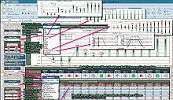 RF Cascade Workbook is the next phase in the evolution of
RF Cafe's long-running series, RF Cascade Workbook. Chances are you have
never used a spreadsheet quite like this (click here for screen capture). It is a full-featured RF system
cascade parameter and frequency planner that includes filters and mixers for a mere
$45. Built in MS Excel, using RF Cascade Workbook 2018 is a cinch
and the format is entirely customizable. It is significantly easier and faster than
using a multi-thousand dollar simulator when a high level system analysis is all
that is needed. An intro video takes you through the main features...
RF Cascade Workbook is the next phase in the evolution of
RF Cafe's long-running series, RF Cascade Workbook. Chances are you have
never used a spreadsheet quite like this (click here for screen capture). It is a full-featured RF system
cascade parameter and frequency planner that includes filters and mixers for a mere
$45. Built in MS Excel, using RF Cascade Workbook 2018 is a cinch
and the format is entirely customizable. It is significantly easier and faster than
using a multi-thousand dollar simulator when a high level system analysis is all
that is needed. An intro video takes you through the main features...
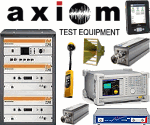 Axiom Test Equipment allows you to
rent or
buy test equipment,
repair
test equipment, or sell or trade test equipment. They are committed to providing
superior customer service and high quality electronic test equipment. Axiom offers
customers several practical, efficient, and cost effective solutions for their projects'
TE needs and is committed to providing superior customer service and high quality
electronic test equipment. For anyone seeking a way to offload surplus or obsolete
equipment, they offer a trade-in program or they will buy the equipment from you.
Some vintage items are available fully calibrated. Please check out Axiom Test Equipment
today - and don't miss the blog articles! Axiom Test Equipment allows you to
rent or
buy test equipment,
repair
test equipment, or sell or trade test equipment. They are committed to providing
superior customer service and high quality electronic test equipment. Axiom offers
customers several practical, efficient, and cost effective solutions for their projects'
TE needs and is committed to providing superior customer service and high quality
electronic test equipment. For anyone seeking a way to offload surplus or obsolete
equipment, they offer a trade-in program or they will buy the equipment from you.
Some vintage items are available fully calibrated. Please check out Axiom Test Equipment
today - and don't miss the blog articles!
Tuesday the 3rd
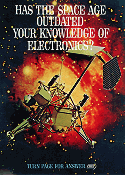 Capitol Radio Engineering Institute (CREI)
was a major player in the home study industry, having been established in 1927 at
the beginning of the rapidly growing field of electronics. As computers came on
the scene, CREI changed its name to Capitol Institute of Technology in order to
diversify its training. Now known as Capitol Technology University, curriculums
through doctorate level are offered for astronautics and aeronautics, electronics,
computers, robotics, software, cybersecurity, and other high tech arenas. I like
their motto: "It's 2023. Every job is a technology job." In 1963 when this four-page
spread appeared in Radio−Electronics magazine, the world's superpowers (primarily
the U.S. and U.S.S.R.) were deep into the Space Race, seeking to establish dominance
and superiority in the realms of manned spaceflight and satellite deployment. The
effort really took off (pun intended) in the mid-to-late 1950s during the International
Geographical Year (IGY) efforts by a consortium of countries to learn as much as
possible about the Earth's upper atmosphere and outer space. As with aeronautics
and aircraft flight, the public was enthralled with the concepts of space flight... Capitol Radio Engineering Institute (CREI)
was a major player in the home study industry, having been established in 1927 at
the beginning of the rapidly growing field of electronics. As computers came on
the scene, CREI changed its name to Capitol Institute of Technology in order to
diversify its training. Now known as Capitol Technology University, curriculums
through doctorate level are offered for astronautics and aeronautics, electronics,
computers, robotics, software, cybersecurity, and other high tech arenas. I like
their motto: "It's 2023. Every job is a technology job." In 1963 when this four-page
spread appeared in Radio−Electronics magazine, the world's superpowers (primarily
the U.S. and U.S.S.R.) were deep into the Space Race, seeking to establish dominance
and superiority in the realms of manned spaceflight and satellite deployment. The
effort really took off (pun intended) in the mid-to-late 1950s during the International
Geographical Year (IGY) efforts by a consortium of countries to learn as much as
possible about the Earth's upper atmosphere and outer space. As with aeronautics
and aircraft flight, the public was enthralled with the concepts of space flight...
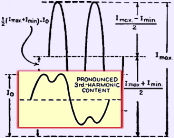 As with so many topics, the basics of topics
like
harmonic distortion (and other forms of distortion) in an amplifier circuit
has not changed much - if at all - over the decades. Test equipment and circuits
being measured get more advanced, but, especially if you are new to the concept,
articles like this one on audio-frequency distortion from a 1941 edition of Radio-Craft
magazine are as useful today as it was when it was written. When studying, in particular,
harmonic distortion, having a knowledge of the Fourier series for common waveforms
like triangle waves, sawtooth waves, square waves, and even a semi-circle- shaped
wave is especially enlightening since it explains a lot of waveform shapes where
harmonics are present... As with so many topics, the basics of topics
like
harmonic distortion (and other forms of distortion) in an amplifier circuit
has not changed much - if at all - over the decades. Test equipment and circuits
being measured get more advanced, but, especially if you are new to the concept,
articles like this one on audio-frequency distortion from a 1941 edition of Radio-Craft
magazine are as useful today as it was when it was written. When studying, in particular,
harmonic distortion, having a knowledge of the Fourier series for common waveforms
like triangle waves, sawtooth waves, square waves, and even a semi-circle- shaped
wave is especially enlightening since it explains a lot of waveform shapes where
harmonics are present...
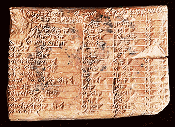 "At least 1,000 years before the Greek mathematician
Pythagoras looked at a right angled triangle and worked out that the square of the
longest side is always equal to the sum of the squares of the other two, an unknown
Babylonian genius took a clay tablet and a reed pen and marked out not just the
same theorem, but a series of
trigonometry tables which scientists claim are more accurate than any available
today. The 3,700-year-old broken clay tablet survives in the collections of Columbia
University, and scientists now believe they have cracked its secrets. The team from
the University of New South Wales in Sydney believe that the four columns and 15
rows of cuneiform – wedge shaped indentations made in the wet clay – represent the
world's oldest and most accurate working trigonometric table, a working tool which
could have been used in surveying, and in calculating how to construct temples,
palaces and pyramids..." "At least 1,000 years before the Greek mathematician
Pythagoras looked at a right angled triangle and worked out that the square of the
longest side is always equal to the sum of the squares of the other two, an unknown
Babylonian genius took a clay tablet and a reed pen and marked out not just the
same theorem, but a series of
trigonometry tables which scientists claim are more accurate than any available
today. The 3,700-year-old broken clay tablet survives in the collections of Columbia
University, and scientists now believe they have cracked its secrets. The team from
the University of New South Wales in Sydney believe that the four columns and 15
rows of cuneiform – wedge shaped indentations made in the wet clay – represent the
world's oldest and most accurate working trigonometric table, a working tool which
could have been used in surveying, and in calculating how to construct temples,
palaces and pyramids..."
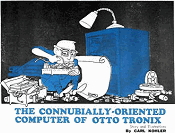 Admittedly, I needed to look up the meaning
of "connubial" when seeing the title of this tongue-in-cheek article by
Carl Kohler in the July 1969 issue of Popular Electronics magazine.
Nobody knows for sure whether the over-enthusiastic starring male in the series
of techie stories that ran in Popular Electronics magazine in the 1950s
was actually Carl himself or an alter ego version of himself. Carl was also the
artist of numerous tech-related comics. His wife, affectionately referred to as
"Old Big Eyes" and a certified "lady-telepath" is always quick to recognize the
impending disaster about to ensue, often with her as an unwilling participant. This
episode deviates a bit from the already-married type to report on the exploits of
born loser Otto Tronix... Admittedly, I needed to look up the meaning
of "connubial" when seeing the title of this tongue-in-cheek article by
Carl Kohler in the July 1969 issue of Popular Electronics magazine.
Nobody knows for sure whether the over-enthusiastic starring male in the series
of techie stories that ran in Popular Electronics magazine in the 1950s
was actually Carl himself or an alter ego version of himself. Carl was also the
artist of numerous tech-related comics. His wife, affectionately referred to as
"Old Big Eyes" and a certified "lady-telepath" is always quick to recognize the
impending disaster about to ensue, often with her as an unwilling participant. This
episode deviates a bit from the already-married type to report on the exploits of
born loser Otto Tronix...
 RF Cascade Workbook is the next phase in the evolution of
RF Cafe's long-running series, RF Cascade Workbook. Chances are you have
never used a spreadsheet quite like this (click here for screen capture). It is a full-featured RF system
cascade parameter and frequency planner that includes filters and mixers for a mere
$45. Built in MS Excel, using RF Cascade Workbook 2018 is a cinch
and the format is entirely customizable. It is significantly easier and faster than
using a multi-thousand dollar simulator when a high level system analysis is all
that is needed. An intro video takes you through the main features...
RF Cascade Workbook is the next phase in the evolution of
RF Cafe's long-running series, RF Cascade Workbook. Chances are you have
never used a spreadsheet quite like this (click here for screen capture). It is a full-featured RF system
cascade parameter and frequency planner that includes filters and mixers for a mere
$45. Built in MS Excel, using RF Cascade Workbook 2018 is a cinch
and the format is entirely customizable. It is significantly easier and faster than
using a multi-thousand dollar simulator when a high level system analysis is all
that is needed. An intro video takes you through the main features...
 Windfreak Technologies designs, manufactures,
tests and sells high value USB powered and controlled radio frequency products
such as RF signal generators, RF synthesizers, RF power detectors, mixers, up /
downconverters. Since the conception of WFT, we have introduced products that have
been purchased by a wide range of customers, from hobbyists to education facilities
to government agencies. Worldwide customers include Europe, Australia, and Asia.
Please contact Windfreak today to learn how they might help you with your current
project. Windfreak Technologies designs, manufactures,
tests and sells high value USB powered and controlled radio frequency products
such as RF signal generators, RF synthesizers, RF power detectors, mixers, up /
downconverters. Since the conception of WFT, we have introduced products that have
been purchased by a wide range of customers, from hobbyists to education facilities
to government agencies. Worldwide customers include Europe, Australia, and Asia.
Please contact Windfreak today to learn how they might help you with your current
project.
Monday the 2nd
 When this 1963 issue of Radio−Electronics
magazine was published, scientists were at the early stages of understanding the
ionosphere. We tend to take our knowledge of it for granted now because so much
has been learned about it in the subsequent six decades. In April of 1961, Russia
launched Yuri Gagarin into space, traversing the ionosphere to attain a 200-mile
orbital altitude. The ionosphere ranges between about 50 and 400 miles high, depending
on solar activity. Charge data was/is necessary in order to take proper precautions
for shielding electronics and life from its potentially harmful effects. Sounding
rockets were a major player in the investigation. Moving on, the comments made by
Bell Lab's research directory John R. Pierce regarding the usefulness of a computer
for data retrieval (versus data calculation) are great fodder for some of the world's
stupidest proclamations. Read on to see what I mean. Finally, the
numerical prefixes "femto" (10-15) and "atto" (10-18) had just been added to
the lexicon of science and mathematics... When this 1963 issue of Radio−Electronics
magazine was published, scientists were at the early stages of understanding the
ionosphere. We tend to take our knowledge of it for granted now because so much
has been learned about it in the subsequent six decades. In April of 1961, Russia
launched Yuri Gagarin into space, traversing the ionosphere to attain a 200-mile
orbital altitude. The ionosphere ranges between about 50 and 400 miles high, depending
on solar activity. Charge data was/is necessary in order to take proper precautions
for shielding electronics and life from its potentially harmful effects. Sounding
rockets were a major player in the investigation. Moving on, the comments made by
Bell Lab's research directory John R. Pierce regarding the usefulness of a computer
for data retrieval (versus data calculation) are great fodder for some of the world's
stupidest proclamations. Read on to see what I mean. Finally, the
numerical prefixes "femto" (10-15) and "atto" (10-18) had just been added to
the lexicon of science and mathematics...
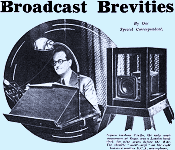 As the old saying goes, "The more things
change, the more things stay the same." Incredibly, back in 1931 people were complaining
about
shrinking office cubicle sizes. To wit: "At 'Broadcasting House' rooms measuring
8ft. x 6ft. are being coveted by the many people who will be condemned to labour
in cubicles 7ft. x 5ft. The Civil Engineer himself, who helped to design and erect
the building, works in a compartment in which, as the American said, 'You couldn't
cuss a cat without getting hair on your teeth.'" ...and whoa!, dig this statement
by the author regarding the demise of "local oscillators" in the UK (noisy regenerative
Rx LO interference*): "Steps might be taken to ensure the survival of a few specimens,
perhaps by the founding of a national reservation similar to those which accommodate
the Red Indians in America. The few remaining squealers and their squaws could then
re-radiate to their hearts' content..." As the old saying goes, "The more things
change, the more things stay the same." Incredibly, back in 1931 people were complaining
about
shrinking office cubicle sizes. To wit: "At 'Broadcasting House' rooms measuring
8ft. x 6ft. are being coveted by the many people who will be condemned to labour
in cubicles 7ft. x 5ft. The Civil Engineer himself, who helped to design and erect
the building, works in a compartment in which, as the American said, 'You couldn't
cuss a cat without getting hair on your teeth.'" ...and whoa!, dig this statement
by the author regarding the demise of "local oscillators" in the UK (noisy regenerative
Rx LO interference*): "Steps might be taken to ensure the survival of a few specimens,
perhaps by the founding of a national reservation similar to those which accommodate
the Red Indians in America. The few remaining squealers and their squaws could then
re-radiate to their hearts' content..."
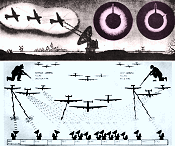 RF Cafe website visitor Ken H. sent
me two PDF files containing "Introduction to Electronic Warfare" (v1,
v2) from
the U.S. Army Security Training Center and School, published after the Korean War
(no date given, but 1959 appears in the manual). Most of the information refers
to World Wars I and II. It begins with the history of EW in the early
days of radio with France and Austria, c1908. The science evolved into electronic
countermeasures (ECM) and electronic counter counter measures (ECCM). ECNM,
where N is the number of C's, is not discussed ;) If you are a fan of government
acronyms and clever nomenclatures, then you'll love this text. Meaconing (masking
beacon), Headache and Aspirin, Ruffian and Bromide, Starfish, Benito and Domino,
Freya, Wurzburg, Window, Carpet, Rug, Jackal, and Airborne Cigar are amongst the
plethora of systems and tactics. Both (or all) sides, continuing into today, are
constantly devising ways to surveil the enemy and to thwart the efforts of the enemy
to surveil you. The entire EW scenario is reminiscent of the old
Spy vs. Spy comic from
Mad magazine. Although not mentioned in this text since it was not sufficiently
developed until after WWII, a good example of early ECM is the frequency-hopping
spread spectrum secure broadcast system dreamed up by
Hedy Lamarr. RF Cafe website visitor Ken H. sent
me two PDF files containing "Introduction to Electronic Warfare" (v1,
v2) from
the U.S. Army Security Training Center and School, published after the Korean War
(no date given, but 1959 appears in the manual). Most of the information refers
to World Wars I and II. It begins with the history of EW in the early
days of radio with France and Austria, c1908. The science evolved into electronic
countermeasures (ECM) and electronic counter counter measures (ECCM). ECNM,
where N is the number of C's, is not discussed ;) If you are a fan of government
acronyms and clever nomenclatures, then you'll love this text. Meaconing (masking
beacon), Headache and Aspirin, Ruffian and Bromide, Starfish, Benito and Domino,
Freya, Wurzburg, Window, Carpet, Rug, Jackal, and Airborne Cigar are amongst the
plethora of systems and tactics. Both (or all) sides, continuing into today, are
constantly devising ways to surveil the enemy and to thwart the efforts of the enemy
to surveil you. The entire EW scenario is reminiscent of the old
Spy vs. Spy comic from
Mad magazine. Although not mentioned in this text since it was not sufficiently
developed until after WWII, a good example of early ECM is the frequency-hopping
spread spectrum secure broadcast system dreamed up by
Hedy Lamarr.
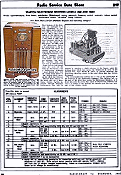 Well shazam, I found a radio service datasheet
that had been missed. This one for the
Sparton Selectronne Model 1068 brings the grand total to 220 that have been
scanned and posted here on RF Cafe. They appeared in various formats in Radio−Craft,
Radio News, and Radio & Television News magazines. It was in the 1930s that
pushbutton tuning appeared in most radio sets, both tabletop and floor-sitting console
models. Those mechanical pushbutton tuner mechanisms were pretty impressive. The
Selectronne also sported a popular visual tuning indicator called the Viso-Glo tube.
It was not a true cat's eye in that the relative brightness of the tube's glow changed
with the received station signal strength, rather than the width of the illuminated
area changing... Well shazam, I found a radio service datasheet
that had been missed. This one for the
Sparton Selectronne Model 1068 brings the grand total to 220 that have been
scanned and posted here on RF Cafe. They appeared in various formats in Radio−Craft,
Radio News, and Radio & Television News magazines. It was in the 1930s that
pushbutton tuning appeared in most radio sets, both tabletop and floor-sitting console
models. Those mechanical pushbutton tuner mechanisms were pretty impressive. The
Selectronne also sported a popular visual tuning indicator called the Viso-Glo tube.
It was not a true cat's eye in that the relative brightness of the tube's glow changed
with the received station signal strength, rather than the width of the illuminated
area changing...
 Banner Ads are rotated in all locations
on the page! RF Cafe typically receives 8,000-15,000 visits each
weekday. RF Cafe
is a favorite of engineers, technicians, hobbyists, and students all over the world.
With more than 17,000 pages in the Google search index, RF Cafe returns in
favorable positions on many types of key searches, both for text and images.
Your Banner Ads are displayed on average 225,000 times per year! New content
is added on a daily basis, which keeps the major search engines interested enough
to spider it multiple times each day. Items added on the homepage often can be found
in a Google search within a few hours of being posted. If you need your company news to be seen, RF Cafe is the
place to be... Banner Ads are rotated in all locations
on the page! RF Cafe typically receives 8,000-15,000 visits each
weekday. RF Cafe
is a favorite of engineers, technicians, hobbyists, and students all over the world.
With more than 17,000 pages in the Google search index, RF Cafe returns in
favorable positions on many types of key searches, both for text and images.
Your Banner Ads are displayed on average 225,000 times per year! New content
is added on a daily basis, which keeps the major search engines interested enough
to spider it multiple times each day. Items added on the homepage often can be found
in a Google search within a few hours of being posted. If you need your company news to be seen, RF Cafe is the
place to be...
 Berkeley Nucleonics Corporation (BNC) is
a leading manufacturer of precision electronic instrumentation for test, measurement,
and nuclear research. Founded in 1963, BNC initially developed custom pulse generators.
We became known for meeting the most stringent requirements for high precision and
stability, and for producing instruments of unsurpassed reliability and performance.
We continue to maintain a leadership position as a developer of custom pulse, signal,
light, and function generators. Our designs incorporate the latest innovations in
software and hardware engineering, surface mount production, and automated testing
procedures. Berkeley Nucleonics Corporation (BNC) is
a leading manufacturer of precision electronic instrumentation for test, measurement,
and nuclear research. Founded in 1963, BNC initially developed custom pulse generators.
We became known for meeting the most stringent requirements for high precision and
stability, and for producing instruments of unsurpassed reliability and performance.
We continue to maintain a leadership position as a developer of custom pulse, signal,
light, and function generators. Our designs incorporate the latest innovations in
software and hardware engineering, surface mount production, and automated testing
procedures.
Sunday the 1st
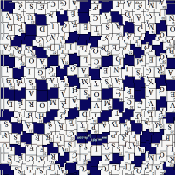 This custom RF Cafe
electronics-themed crossword puzzle for October 1st contains words and clues
which pertain exclusively to the subjects of electronics, science, physics, mechanics,
engineering, power distribution, astronomy, chemistry, etc. If you do see names
of people or places, they are intimately related to the aforementioned areas of
study. Being that "A" is the 1st letter of the alphabet, it is used as the first
and/or last letter of many words in today's crossword puzzle - as well as in-between.
Those clues are marked with an asterisk (*, or **, depending on the number of them
in the word). As always, you will find no references to numbnut movie stars or fashion
designers. Need more crossword RF Cafe puzzles? A list at the bottom of the page
links to hundreds of them dating back to the year 2000. Enjoy. This custom RF Cafe
electronics-themed crossword puzzle for October 1st contains words and clues
which pertain exclusively to the subjects of electronics, science, physics, mechanics,
engineering, power distribution, astronomy, chemistry, etc. If you do see names
of people or places, they are intimately related to the aforementioned areas of
study. Being that "A" is the 1st letter of the alphabet, it is used as the first
and/or last letter of many words in today's crossword puzzle - as well as in-between.
Those clues are marked with an asterisk (*, or **, depending on the number of them
in the word). As always, you will find no references to numbnut movie stars or fashion
designers. Need more crossword RF Cafe puzzles? A list at the bottom of the page
links to hundreds of them dating back to the year 2000. Enjoy.
 This assortment of custom-designed themes
by RF Cafe includes T-Shirts, Mouse Pads, Clocks, Tote Bags, Coffee Mugs and Steins,
Purses, Sweatshirts, Baseball Caps, and more, all sporting my amazingly clever "RF Engineers - We
Are the World's Matchmakers" Smith chart design. These would make excellent
gifts for husbands, wives, kids, significant others, and for handing out at company
events or as rewards for excellent service. My graphic has been ripped off by other
people and used on their products, so please be sure to purchase only official RF
Cafe gear. I only make a couple bucks on each sale - the rest goes to Cafe Press.
It's a great way to help support RF Cafe. Thanks... This assortment of custom-designed themes
by RF Cafe includes T-Shirts, Mouse Pads, Clocks, Tote Bags, Coffee Mugs and Steins,
Purses, Sweatshirts, Baseball Caps, and more, all sporting my amazingly clever "RF Engineers - We
Are the World's Matchmakers" Smith chart design. These would make excellent
gifts for husbands, wives, kids, significant others, and for handing out at company
events or as rewards for excellent service. My graphic has been ripped off by other
people and used on their products, so please be sure to purchase only official RF
Cafe gear. I only make a couple bucks on each sale - the rest goes to Cafe Press.
It's a great way to help support RF Cafe. Thanks...
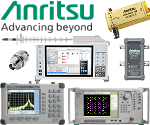 Anritsu has been a global provider of innovative
communications test and measurement solutions for more than 120 years. Anritsu manufactures
a full line of innovative components and accessories for
RF and Microwave Test and Measurement
Equipment including attenuators & terminations; coaxial cables, connectors &
adapters; o-scopes; power meters & sensors; signal generators; antenna, signal,
spectrum, & vector network analyzers (VNAs); calibration kits; Bluetooth &
WLAN testers; PIM testers; amplifiers; power dividers; antennas. "We've Got You
Covered." Anritsu has been a global provider of innovative
communications test and measurement solutions for more than 120 years. Anritsu manufactures
a full line of innovative components and accessories for
RF and Microwave Test and Measurement
Equipment including attenuators & terminations; coaxial cables, connectors &
adapters; o-scopes; power meters & sensors; signal generators; antenna, signal,
spectrum, & vector network analyzers (VNAs); calibration kits; Bluetooth &
WLAN testers; PIM testers; amplifiers; power dividers; antennas. "We've Got You
Covered."
|



 Hall effect devices
Hall effect devices






 Innovative Power Products
Innovative Power Products




 "YL" in amateur-ese stands for "young lady."
"YL" in amateur-ese stands for "young lady."

 Capitol Radio Engineering Institute (CREI)
Capitol Radio Engineering Institute (CREI)








 Berkeley Nucleonics Corporation (BNC)
Berkeley Nucleonics Corporation (BNC)
